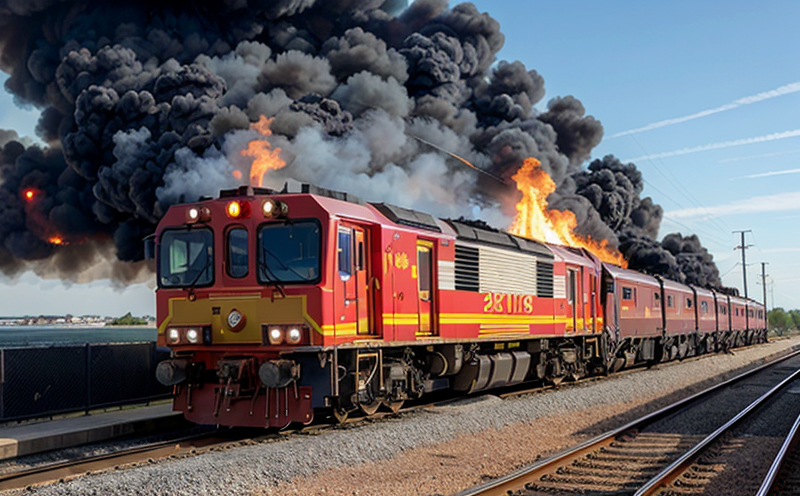Laboratory Documentation of Marine Fire Tests
In the realm of fire safety testing, particularly within the sectors of marine and railway engineering, accurate and reliable laboratory documentation is crucial. This service focuses on providing comprehensive documentation for marine fire tests conducted in a controlled environment. Our laboratory adheres to international standards such as ISO 6941-7:2015 and ASTM E1354, ensuring that the testing process meets stringent quality requirements.
The first step involves selecting the appropriate specimen. This could be any material or component critical to marine fire safety, ranging from structural elements like wood, steel, and composite materials to electrical components such as wiring systems. Once selected, these specimens undergo rigorous preparation which includes cleaning, drying, and conditioning according to ISO standards.
The testing process itself is conducted using advanced equipment designed specifically for marine environments. This includes specialized burners capable of simulating various fire scenarios under controlled conditions. The apparatus used ensures that the test replicates real-world conditions as closely as possible while maintaining safety protocols.
After the test, our team meticulously documents every aspect of it. From initial setup to final results, each stage is recorded with precision. We provide detailed reports encompassing all relevant data points including temperatures reached during combustion, flame spread rates, smoke production indices, and more. These reports are invaluable tools for quality managers, compliance officers, R&D engineers, and procurement teams involved in ensuring maritime safety.
Accurate documentation not only aids in meeting regulatory requirements but also plays a pivotal role in continuous improvement efforts. By analyzing these records, stakeholders can identify areas needing enhancement or revision, fostering an ongoing cycle of innovation within the industry.
Why Choose This Test
This test ensures compliance with international standards like ISO 6941-7:2015 and ASTM E1354 which are specifically designed to address marine fire safety concerns. Compliance is essential for maintaining high levels of safety across all maritime operations.
The detailed documentation provided through this service helps in identifying potential risks early on, allowing for proactive measures to be taken before they escalate into significant issues.
It supports continuous improvement initiatives by offering insights derived from past tests that can inform future designs and processes.
The comprehensive nature of the documentation makes it easier for stakeholders to communicate effectively about fire safety matters, facilitating better collaboration between different departments within organizations.
By choosing this service, you gain access to expert knowledge and state-of-the-art facilities that can help safeguard your assets against fires. The robust documentation generated ensures peace of mind knowing that every precaution has been taken when it comes to marine fire safety.
Quality and Reliability Assurance
The quality and reliability assurance processes associated with our laboratory documentation service are second to none. Our team employs rigorous quality control measures at every stage of the testing process, from specimen selection through final reporting. This commitment ensures that all data provided is accurate and reliable.
We use only the most advanced instrumentation calibrated according to strict tolerances set by relevant standards bodies. Regular calibration checks are performed to maintain precision throughout each test run. Additionally, our personnel undergo continuous training in best practices related to fire testing techniques, ensuring they stay updated on latest methodologies and technologies.
Furthermore, we implement comprehensive record-keeping systems that track every aspect of the testing process. This includes documentation of all adjustments made during the course of a test, as well as any deviations from expected outcomes. Such thoroughness guarantees transparency and accountability in our operations.
Use Cases and Application Examples
| Use Case | Description |
|---|---|
| Material Selection | Determining the suitability of different materials for use in marine environments based on their resistance to fire. |
| Design Validation | Verifying that newly designed components meet required safety standards before being incorporated into larger systems. |
| Operational Optimization | Evaluating existing facilities and practices in order to optimize performance while minimizing risk factors associated with fire hazards. |
| New Technology Introduction | Assessing new materials or technologies intended for use within maritime contexts, ensuring they comply with applicable regulations. |
| Risk Assessment | Identifying potential points of vulnerability in existing infrastructure and recommending modifications to enhance overall safety levels. |
| Training Programs | Providing data that can be used for educational purposes, helping train personnel on best practices related to fire prevention and response strategies. |
The above table illustrates several scenarios where laboratory documentation of marine fire tests proves beneficial. In each case, the detailed records generated by our service play a crucial role in decision-making processes aimed at enhancing safety standards across various maritime sectors.





